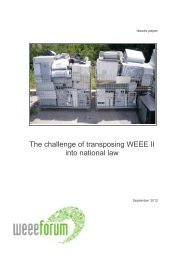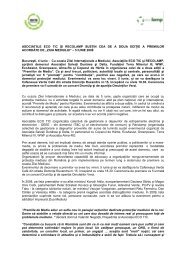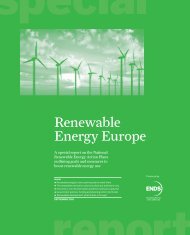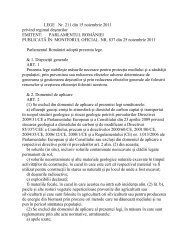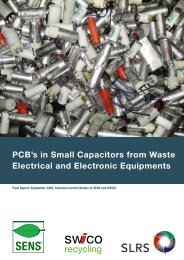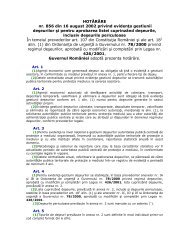Requirements for the Collection, Transportation, Storage and - Ecotic
Requirements for the Collection, Transportation, Storage and - Ecotic
Requirements for the Collection, Transportation, Storage and - Ecotic
You also want an ePaper? Increase the reach of your titles
YUMPU automatically turns print PDFs into web optimized ePapers that Google loves.
<strong>Requirements</strong> <strong>for</strong> <strong>the</strong> <strong>Collection</strong>, <strong>Transportation</strong>, <strong>Storage</strong><br />
<strong>and</strong> Treatment of Cooling <strong>and</strong> Freezing Appliances<br />
containing Hydrocarbons (HC)<br />
1. Introduction<br />
18 October 2006<br />
The use of Chlorofluorocarbons (CFCs) in <strong>the</strong> production of insulation foams <strong>and</strong><br />
refrigerant circuits <strong>for</strong> cooling <strong>and</strong> freezing appliances was banned in <strong>the</strong> mid-1990s<br />
[1].<br />
As a consequence <strong>the</strong> producers of cooling appliances developed a new technology<br />
based on <strong>the</strong> use of pure Hydrocarbons (HC) such as butane, propane <strong>and</strong> pentane<br />
instead of CFCs as usable refrigerants.<br />
Cyclopentane continues to be used almost exclusively as <strong>the</strong> blowing agent of choice<br />
<strong>for</strong> <strong>the</strong> polyurethane (PUR) foam insulation.<br />
One of <strong>the</strong> main characteristics, in comparison with CFC, H-CFC <strong>and</strong> HFC [2] is that<br />
HC has no ozone depleting potential (ODP) <strong>and</strong> only a low global warming potential<br />
(GWP) (see Figure 1).<br />
Figure 1: environmental impacts of blowing agents in PUR-foam<br />
In total <strong>the</strong> environmental impact of HC is marginal in comparison to CFC.<br />
The new cooling <strong>and</strong> freezing appliances - so-called HC-appliances - increasingly<br />
emerge at collection facilities <strong>for</strong> WEEE <strong>and</strong> in following treatment processes. For<br />
2006 <strong>the</strong> estimated share lies at around 10-30 % of <strong>the</strong> total amount of treated waste<br />
cooling <strong>and</strong> freezing appliances collected <strong>and</strong> treated in Europe [3].<br />
[1] Regulation No 2037/2000 of <strong>the</strong> European Parliament <strong>and</strong> of <strong>the</strong> Council of 29 June 2000 on<br />
substances that deplete <strong>the</strong> ozone layer.<br />
[2] Chlorofluorocarbon (CFC), Hydrochlorofluorocarbon (HCFC) <strong>and</strong> Hydrofluorocarbon (HFC)<br />
[3] It is expected that <strong>the</strong> estimated share of waste HC appliances in <strong>the</strong> WEEE stream will increase in<br />
<strong>the</strong> future. The requirements presented in this paper are based on practices <strong>and</strong> best available<br />
1
The potential HC emissions from treatment of cooling <strong>and</strong> freezing appliances<br />
represent only a small part of <strong>the</strong> total annual VOC emissions.<br />
2. Objective<br />
The objective of <strong>the</strong> following specifications is to set up requirements <strong>for</strong> <strong>the</strong> collection,<br />
transport, storage <strong>and</strong> treatment of HC containing cooling <strong>and</strong> freezing appliances in<br />
order to ensure low environmental impact <strong>and</strong> to secure <strong>the</strong> respect of <strong>the</strong> necessary<br />
safety measures.<br />
This can be assured by treatment in specialised treatment plants <strong>for</strong> waste cooling <strong>and</strong><br />
freezing appliances that comply with all European Community legislation on health,<br />
safety <strong>and</strong> environment.<br />
3. General requirements<br />
The requirements apply to <strong>the</strong> separation of HC as liquids <strong>and</strong>/or gases from cooling<br />
<strong>and</strong> freezing appliances <strong>for</strong> recovery or disposal by means of dismantling <strong>and</strong><br />
treatment [4].<br />
Overall this document consists of a set of requirements concerning:<br />
• <strong>Collection</strong>, storage, transport <strong>and</strong> h<strong>and</strong>ling<br />
• Recovery or disposal of HC<br />
• HC emissions to <strong>the</strong> surrounding<br />
• Use of output fractions (recovery <strong>and</strong> recycling targets of 80% <strong>and</strong> 75% respectively,<br />
<strong>the</strong>se targets as according to Directive 2002/96/EC or future amended versions)<br />
• Safety measures<br />
• Quality assurance<br />
• Inspection <strong>and</strong> control<br />
With <strong>the</strong>se requirements also o<strong>the</strong>r legal aspects shall be covered:<br />
1. Safety features at <strong>the</strong> construction of treatment plant [5].<br />
2. Precautionary safety measures during <strong>the</strong> whole process [6].<br />
3. Environmental sound treatment, recovery, recycling <strong>and</strong> disposal of hazardous<br />
substances [7].<br />
technologies of today. It may be that new <strong>and</strong> better practices <strong>and</strong> technologies will emerge in <strong>the</strong> next<br />
5 to 10 years. The signatories commit to reviewing <strong>the</strong> requirements document after a period of 5 years<br />
or when new developments make a revision necessary.<br />
[4] Step 1 <strong>for</strong> <strong>the</strong> separation of HC <strong>and</strong> oil from <strong>the</strong> cooling circuits <strong>and</strong> step 2 <strong>for</strong> <strong>the</strong> separation of HC<br />
from <strong>the</strong> foam <strong>for</strong> recovery or disposal <strong>and</strong> <strong>the</strong> separation of recyclable <strong>and</strong> recoverable materials<br />
(metals, glass, plastics, cables etc.).<br />
[5] Directive 94/9/EC on <strong>the</strong> approximation of <strong>the</strong> laws of <strong>the</strong> Member States concerning equipment <strong>and</strong><br />
protective systems intended <strong>for</strong> use in potentially explosive atmospheres<br />
[6[ Directive 1999/92/EC on minimum requirements <strong>for</strong> improving <strong>the</strong> safety <strong>and</strong> health protection of<br />
workers potentially at risk from explosive atmospheres (15th individual Directive within <strong>the</strong> meaning of<br />
Article 16(1) of Directive 89/391/EEC)<br />
2
4. National legal requirements concerning HC emissions.<br />
4. <strong>Collection</strong>, <strong>Storage</strong>, Transport <strong>and</strong> H<strong>and</strong>ling<br />
1. Sorting of types of cooling <strong>and</strong> freezing appliances [8] shall take place at <strong>the</strong><br />
treatment plant.<br />
2. Sorting of types of cooling <strong>and</strong> freezing appliances <strong>for</strong> end of life treatment in<br />
advance of <strong>the</strong> treatment process shall be per<strong>for</strong>med by <strong>and</strong> supervised by trained<br />
personnel <strong>and</strong> in accordance with <strong>the</strong> treatment requirements of cooling <strong>and</strong><br />
freezing appliances.<br />
3. The signatories of this document commit to not allowing in <strong>the</strong>ir contracts with<br />
collection points, or with any party collecting appliances, to pre-sort types of cooling<br />
<strong>and</strong> freezing appliances <strong>for</strong> end of life treatment purposes.<br />
4. <strong>Collection</strong>, storage, transport <strong>and</strong> h<strong>and</strong>ling of cooling <strong>and</strong> freezing appliances shall<br />
be done carefully to avoid damage of <strong>the</strong> appliances <strong>and</strong> leakage of controlled<br />
substances. If oil leakage is recognized, appropriate measures shall be taken to<br />
minimize environmental impacts.<br />
5. All sites <strong>for</strong> storage <strong>and</strong> treatment shall at least be in line with <strong>the</strong> technical<br />
requirements of Annex III of Directive 2002/96/EC.<br />
6. As <strong>for</strong> storage, transport <strong>and</strong> h<strong>and</strong>ling also <strong>the</strong> treatment of HC appliances dem<strong>and</strong><br />
corresponding protective precautionary measures due to <strong>the</strong> flammability of<br />
hydrocarbons. Places where hazardous explosive atmospheres may occur shall be<br />
specially designated. Fur<strong>the</strong>rmore, <strong>the</strong> ban on ignition sources <strong>and</strong> <strong>the</strong> ban on<br />
entering by unauthorized persons shall be labelled <strong>and</strong> en<strong>for</strong>ced (Annex III of<br />
Directive 2002/96/EC).<br />
7. Transports optimisation is allowed as long as <strong>the</strong> initial size of <strong>the</strong> cooling <strong>and</strong><br />
freezing appliances incl. cabinets is not reduced <strong>and</strong> good condition of <strong>the</strong><br />
appliances is ensured.<br />
8. All sites shall demonstrate that <strong>the</strong>y are secured against unauthorised access.<br />
5. Treatment<br />
HC appliances can be treated in many different ways. The right choice of a technology<br />
is not only a question of minimising <strong>the</strong> risk of explosion, but also of getting <strong>the</strong> best<br />
separation results <strong>for</strong> <strong>the</strong> secondary raw-material market.<br />
Even though <strong>the</strong> environmental impact of HC is low (its global warming potential is<br />
below 15) <strong>the</strong> national air limiting values have to be respected.<br />
[7]Directive 2002/96/EC of <strong>the</strong> European Parliament <strong>and</strong> of <strong>the</strong> Council of 27 January 2003 on waste<br />
electrical <strong>and</strong> electronic equipment (WEEE) or corresponding national regulations<br />
[8] “Types of appliances” are distinguished as CFC, H-CFC, HC or NH3 containing appliances.<br />
3
If <strong>the</strong>re is any doubt about <strong>the</strong> type of refrigerant or foaming agent, <strong>the</strong> cooling <strong>and</strong><br />
freezing appliances must be treated as CFC-containing ones. There<strong>for</strong>e also treatment<br />
facilities <strong>for</strong> CFC appliances shall comply with explosion protection measures as<br />
stated in Directive 1999/92/EC.<br />
Cooling <strong>and</strong> freezing appliances <strong>and</strong> components, materials <strong>and</strong> substances <strong>the</strong>reof<br />
have to be processed at a rate of recovery of at least 80% <strong>and</strong> a reuse <strong>and</strong> recycling<br />
rate of at least 75% by weight per appliance [see footnote 7].<br />
The treatment process of end of life cooling <strong>and</strong> freezing appliances is usually<br />
per<strong>for</strong>med in two steps:<br />
Step 1 (removal of all liquids - Article 6.1 [see footnote 7]):<br />
1. All liquids that may contribute to a contamination of separated fractions during or<br />
after <strong>the</strong> treatment process shall be removed.<br />
2. All HC refrigerants [9] shall be separated from oil.<br />
3. HC emissions shall comply with national legislation.<br />
4. All installations shall be equipped <strong>and</strong> operated with protective measures against<br />
possible fires <strong>and</strong> explosions.<br />
If step 1 <strong>and</strong> 2 are being carried out at 2 different physical locations, <strong>the</strong> treatment<br />
company has to ensure that HC cabinets are not been mixed up with CFC cabinets at<br />
<strong>the</strong> time of collection <strong>and</strong> storage or during transport.<br />
Step 2 (Fur<strong>the</strong>r processing of HC cabinets):<br />
It is essential <strong>for</strong> <strong>the</strong> treatment of HC cabinets that <strong>the</strong> necessary safety measures <strong>and</strong><br />
<strong>the</strong> welfare of employees are observed.<br />
1. The treatment of appliances in step 2 shall be carried out with step 1 treated<br />
appliances only (called “cabinets”) from which refrigerants <strong>and</strong> oil have been<br />
removed.<br />
2. HC emissions shall comply with national legislation.<br />
3. In case HCs from <strong>the</strong> insulation foam are not captured, <strong>the</strong>y shall be released in a<br />
controlled manner respecting <strong>the</strong> health <strong>and</strong> safety regulations. Special care to<br />
precautionary safety has to be assured as stated in Directive 1999/92/EC [see<br />
footnote 6].<br />
Explosion protection measures in accordance with Directive 1999/92/EC<br />
Plants shall comply with Directive 1999/92/EC on minimum requirements <strong>for</strong> improving<br />
<strong>the</strong> safety <strong>and</strong> health protection of workers potentially at risk from explosive<br />
atmospheres.<br />
In practice, explosions inside <strong>the</strong> shredder can be avoided by controlling conditions.<br />
Examples of measures to control those conditions:<br />
• Rarefaction of <strong>the</strong> HC atmosphere by blowing air into <strong>the</strong> process or<br />
[9] HC refrigerants used in “Commercial refrigeration equipment” mainly contain HC-290, HC-600a, HC-<br />
1270 or blends of HC-290/HC-600a, ”Household refrigerators” mainly isobutane (HC-600a)<br />
4
• Reduction of <strong>the</strong> oxygen content by substituting air with inert gases [10].<br />
• Use of alternative explosion proof processing-technologies.<br />
6. Quality Assurance<br />
1. Treatment companies <strong>for</strong> HC containing cooling <strong>and</strong> freezing appliances shall have<br />
a certified ISO 9001:2000 <strong>and</strong> ISO 14001, or equivalent audited quality<br />
management systems in place, also covering treatment processes <strong>and</strong> in-house<br />
monitoring.<br />
2. In addition to <strong>the</strong> usual documentation <strong>and</strong> controlling exercised by <strong>the</strong> quality<br />
system, treatment companies are requested to keep operation journals which<br />
register all incoming cooling <strong>and</strong> freezing appliances according to types <strong>and</strong><br />
categories <strong>and</strong> all <strong>the</strong> outgoing materials.<br />
7. Inspection <strong>and</strong> Control<br />
The quantity of separated liquids <strong>and</strong> fractions <strong>and</strong> <strong>the</strong>ir destination of <strong>for</strong>warding shall<br />
be documented in a retrievable way to be compliant with monitoring requirements of<br />
<strong>the</strong> national implementations of Directive 2002/96/EC on waste electrical <strong>and</strong><br />
electronic equipment (WEEE).<br />
1. Compliance with <strong>the</strong> quality requirements will be decided by <strong>the</strong> relevant<br />
environmental authorities, responsible take-back system (individual or collective) or<br />
o<strong>the</strong>r bodies being responsible in <strong>the</strong> respective countries.<br />
2. It is recommended that an independent organisation with adequate knowledge of<br />
<strong>the</strong> treatment processes of cooling <strong>and</strong> freezing appliances will make annual<br />
inspections on behalf of <strong>the</strong> respective body to control <strong>the</strong> following points:<br />
• Publication of annual report of treated HC appliances <strong>and</strong> removed liquids <strong>and</strong>/or<br />
HC cabinets<br />
• The capability of <strong>the</strong> treatment company to comply with requirements put <strong>for</strong>ward<br />
in this document<br />
• Compliance with environmental legal <strong>and</strong> o<strong>the</strong>r requirements (permits, storage<br />
area etc.)<br />
* * * * *<br />
CECED represents <strong>the</strong> household appliance industry in Europe. Its member companies employ over<br />
200,000 people, are mainly based in Europe, <strong>and</strong> have a turnover of about €40 billion. If upstream <strong>and</strong><br />
downstream business is taken toge<strong>the</strong>r, <strong>the</strong> sector employs over 500,000 people. Direct Members are<br />
Arçelik, BSH Bosch und Siemens Hausgeräte, C<strong>and</strong>y Group, De’Longhi, Electrolux Holdings, Fagor,<br />
Gorenje, Liebherr, Indesit Company, Miele, Philips, SEB <strong>and</strong> Whirlpool Europe. CECED’s member<br />
associations cover <strong>the</strong> following countries: Austria, Belgium, Czech Republic, Denmark, Estonia, France,<br />
Germany, Greece, Hungary, Italy, Latvia, Lithuania, Ne<strong>the</strong>rl<strong>and</strong>s, Norway, Pol<strong>and</strong>, Portugal, Romania,<br />
Slovakia, Sweden, Switzerl<strong>and</strong>, Turkey <strong>and</strong> <strong>the</strong> United Kingdom.<br />
The WEEE Forum is an open non-profit association of voluntary industry-driven collective WEEE takeback<br />
systems, taking care of individual producers' responsibility in Europe.<br />
[10] There is a choice between different types of inert gases. Normally nitrogen is used (this is <strong>the</strong> usual<br />
way <strong>for</strong> treatment of HC appliances in treatment plants <strong>for</strong> CFC appliances).<br />
5
EERA, <strong>the</strong> European Electronics Recyclers Association, is a non-profit organisation that promotes <strong>the</strong><br />
interest of recycling companies who are treating waste electrical <strong>and</strong> electronic equipment WEEE in<br />
Europe. EERA aims <strong>for</strong> <strong>the</strong> harmonisation of national <strong>and</strong> international regulations <strong>for</strong> WEEE recycling<br />
in order to obtain a free market <strong>for</strong> dem<strong>and</strong> <strong>and</strong> supply of services. EERA calls <strong>for</strong> environmentally<br />
sound operating practices <strong>for</strong> WEEE recycling activities <strong>and</strong> members are signatories to <strong>the</strong> rules of<br />
conduct to safeguard protection of human health <strong>and</strong> <strong>the</strong> environment.<br />
6



